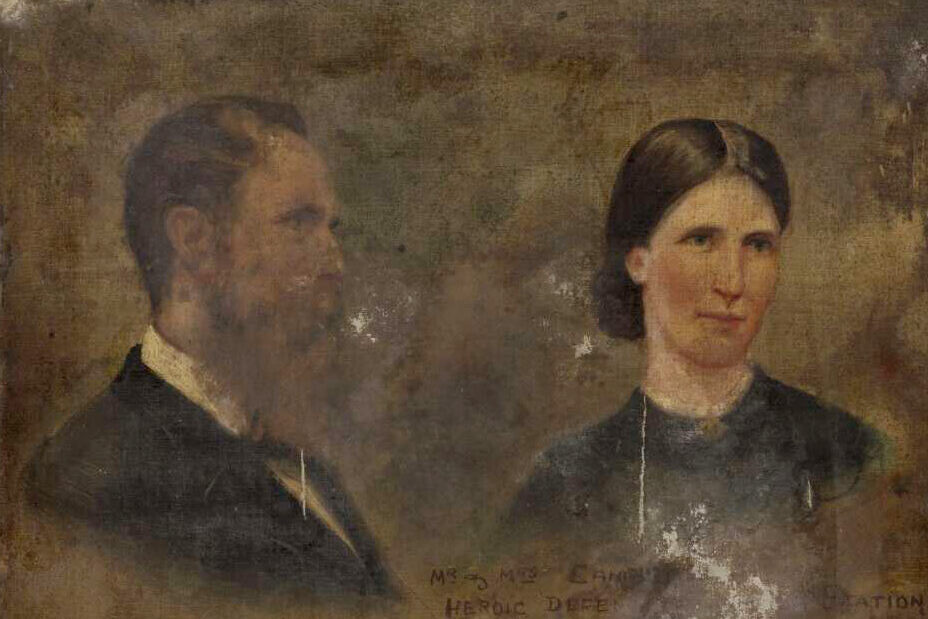The battle of Goimbla Homestead: bushrangers vs landholders

Moving swiftly under the cover of darkness, the armed bushrangers had one objective: to exact revenge on David Campbell, the outspoken landowner who wanted them brought to justice. The ensuing shoot-out would make Campbell and his wife, Amelia, local heroes for courageously defending their property from the colony’s most infamous criminals.
Hall and Gilbert likely met through bushranger Frank Gardiner. On 15 June 1862, Gardiner and his gang – Hall and Gilbert among them – bailed up a gold coach at Escort Rock near Eugowra and fled with 2719oz of gold and £3700 in cash. It was the biggest gold heist in Australian history, equivalent to an estimated $10 million in today’s currency.
In September 1863, Hall and Gilbert had formed their own gang with John O’Meally, John Vane and Mickey Burke and began a three-month crime spree. Newspapers were rife with tales of their exploits: stealing police uniforms and impersonating officers; bailing up stations and households; robbing businesses; and raiding the homestead of Bathurst’s principal gold commissioner, Henry Keightley, who wounded Burke, who then shot himself in the head rather than be captured.

One of the most bizarre acts during this crime spree was the hold-up of Canowindra in October. The Gilbert–Hall gang rounded up the townspeople and travellers in the Robinson’s Hotel, plying them with booze, food and cigars. For three days and nights the bushrangers entertained the townsfolk with dancing and target shooting.
“Great festivities were kept up, and from the description given of the gang, they entertained not the slightest apprehension of being disturbed … their proceedings being characterised by a cool audacity, which has hitherto been unparallelled,” The Empire reported on 20 October 1863.
The Gilbert–Hall gang needed to be stopped. Landowner and justice of the peace David Campbell decided to take matters into his own hands, marshalling an armed party to apprehend the marauding bushrangers. Word soon reached Hall and his gang, who began planning a raid on Campbell’s property.


THEN AND NOW: Goimbla Homestead was destroyed by a fire in 1935. Most of its physical structure has been lost to time – apart from this chimney – but its story has not been erased from history. Image credits: Public Domain/courtesy National Library of Australia; Jason McCarthy/National Museum of Australia
At 9pm on 19 November, Campbell was at Goimbla with Amelia and brother William when he heard footsteps on his veranda. Grabbing his double-barrelled shotgun, he moved through the back door and came face-to-face with one of the bushrangers, possibly O’Meally.
The bushranger fired two shots but missed. Startled, William went outside to investigate. He was shot twice but managed to run for cover. Amelia ran into the drawing room to grab a second shotgun, dodging the bushrangers’ bullets as she retrieved the firearm in the light of the oil lamps and open blinds, which made her an easy target. She rushed back to her husband and they sheltered behind the kitchen’s walls. Campbell reloaded his gun and the shootout continued.

The bushrangers then set fire to the barn, killing the horses trapped inside. They also set fire to a second shed and continued shooting, lying low to avoid the light of the flames.
Growing desperate, Amelia fled from the homestead to rally help from nearby workmen, but only a servant girl came to her aid. Returning to her husband’s side, she soon spotted O’Meally’s cabbage-tree hat illuminated by the light of the fire. Campbell fatally shot him and ended the shootout. Gilbert and Hall dragged O’Meally to a nearby oak tree and pilfered the contents of his pockets before abandoning him.
The next day, after the constable arrived to investigate the scene, O’Meally’s body was removed and buried in an unmarked grave at Gooloogong Cemetery.
The tale of the raid was published in newspapers across the colony. On 24 November, an Empire report described Campbell as a “man who bravely imperilled his life in defence of his family … and who, in the performance of a noble act of duty, ridded society of as ruthless a criminal as ever infested the territory”.


